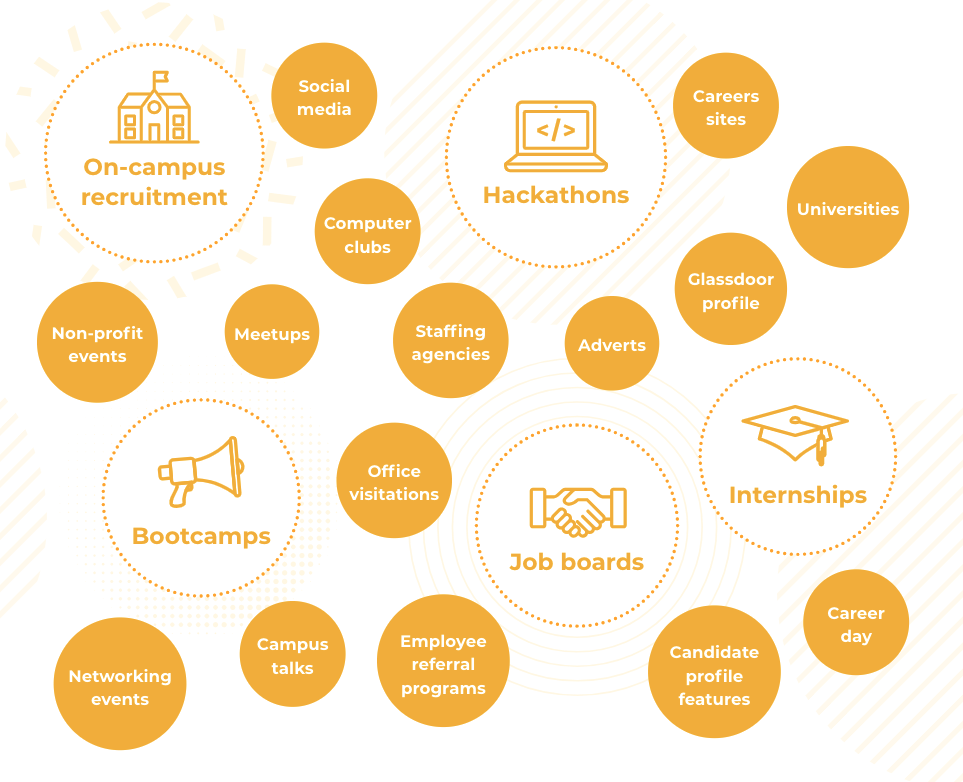Be the first to know
Sign up for a weekly dose of tech hiring news and updates.
Despite the recent layoffs in big tech, the demand for sourcing and hiring qualified software engineers continues to be a major pain point for engineering managers and talent acquisition teams. Tech talent shortages and skill gaps are present across industries, especially in healthcare, financial services, and manufacturing, where there’s a high demand for engineers, but attracting top talent is tough.
87% of executives are experiencing skill gaps in the workforce, but less than half clearly understand how to address the problem. These gaps and talent shortages could result in larger losses, too. The US tech industry alone faces a $162 billion revenue loss caused by talent shortages. By 2030, the global talent shortage could result in about $8.5 trillion in unrealized annual revenues.
Workplace shortages mean hiring teams across industries still have to hire top engineering talent at the same volume as previous years. Still, the consistently low unemployment rate in tech indicates that either the tech workers that were let go quickly re-entered the market or that most layoffs affected non-technical positions.
Where Can You Find Qualified & Talented Engineers That Will Grow With Your Organization?
The answer is hiring junior engineers from traditional and non-traditional educational backgrounds.
The amount of openings for junior developers has dropped by 7%. This means many organizations are scrambling to attract and hire more experienced engineers to fill skill gaps and talent shortages – and excluding a rather large pool of highly qualified junior engineers eager to kickstart their careers and make a long-term investment in your company.
However, finding and selecting the right junior developers can take time due to the competitive landscape and the abundance of candidates. To optimize your hiring process and stand out from your competitors, having the right tools and hiring strategies at your disposal is crucial.
This blog post will guide you through the four key steps of hiring junior engineers that will help fill skill gaps in your organization:
- Finding and attracting candidates
- Screening effectively
- Interviewing for ability and potential
- Retaining talent with a constructive workplace
Challenges in Hiring Junior Software Engineers
Before delving into the strategies for hiring junior engineers, it’s important to understand the common challenges that hiring teams face. These challenges include:
- Differentiating from tech giants: Tech giants have expertise in tech hiring and culture, access to more hiring tools and resources, and stronger employer branding with junior engineers. Standing out from these companies can be difficult.
- Signaling meaningful and rewarding work: It’s crucial to convey to candidates that your company offers meaningful and rewarding work, which can be a significant factor in attracting top talent.
- Focusing on the “unicorn” engineers: Putting too much emphasis on finding engineers with exceptional skills may cause you to overlook other talented candidates.
- Sorting through large talent pools: The sheer volume of candidates can be overwhelming, making it challenging to sort through and identify the most suitable ones effectively.
- Timing limitations: University recruitment can be seasonal, and companies may face time constraints when hiring junior engineers.
Additionally, it’s important to note that engineering managers also need help in technical hiring due to workforce reductions. They must manage diverse skill sets with limited time, budgets, and resources while achieving product goals. They must also continue building distributed teams, hiring senior engineers, improving diversity, and avoiding wasted engineering hours on inadequate candidates with fewer resources.
Now that we’ve identified the challenges, let’s jump into the solutions.
Finding Top Junior Candidates to Fill Skill Gaps
To find talented junior engineers, you can utilize multiple high-impact channels. Here are five effective ways to find such candidates:
- On-campus recruitment: Connect with soon-to-be graduates through career fairs, meetups, and industry talks at select universities.
- Boot camps: Consider recruiting from coding boot camps, which can be an effective channel for junior engineers without a traditional computer science background.
- Hackathons or Coding Challenges: Engage junior engineers by organizing gamified coding challenges, competitions, or hackathons. Use skills testing tools like Codility to benchmark candidates and challenge their technical skills.
- Internships: Offer internships to junior candidates, as they provide an opportunity to assess their potential before extending an actual job offer.
In the quest to build high-performing engineering teams, organizations are starting to recognize the value of prioritizing sourcing strategies like these that focus on potential over traditional barriers to entry.
For example, Wiser, a leading talent acquisition firm, exceeded hiring targets for their client NHS Digital by 62.5%, focusing on strategies catering to early-career talent. By embracing a talent strategy that looked beyond conventional criteria like college degrees, Wiser achieved outstanding results, making 55% more engineering hires for NHS Digital compared to the previous year. This saved valuable recruiting time and brought on board a diverse range of exceptionally talented individuals, exceeding local benchmarks in the UK.
Assessing engineering candidates at recruiting events can be tough. Check out our on demand demo of CodeEvent to see how you can leverage gamified coding challenges to evaluate thousands of participants and find the right hires – every time.
Create a Long-term Brand Strategy
When hiring, growing your brand reputation as a great employer for engineers is extremely important for attracting top tech talent. This should be an extensive part of your recruitment strategy because if you can build up brand awareness, these methods will be more successful and help you compete with tech giants that often have a competitive edge when hiring tech talent.
Things like learning and development opportunities will be a compelling driver for candidates and help your organization stand out to junior engineers, in particular. A recent survey shows that advancement and skill development was the #4 and #5 top priorities for all candidates. This will be especially true for Gen Z tech talent but holds true across the global workforce. Be sure to highlight these perks in strategy and also…
- Encourage thought leadership: Start by featuring junior candidates on your blog or providing resources for your engineers to speak at meetups and events.
- Go beyond a generic job listing: Consider highlighting employer awards, press releases, perks/benefits, and your skills-based hiring strategies and L&D opportunities to help attract junior talent.
- Work as a team: Collaborate with your engineers to better understand what important engineering competencies (including soft skills) are needed before your start sourcing candidates.
- Feedback is essential: To create a brand that resonates with the people you want to attract, consider how you are giving (and receiving feedback) to candidates. Implementing a comprehensive communication plan throughout the hiring process, including candidate feedback, next steps, and a focus on rejected candidates, is crucial for creating a structured and inclusive hiring experience that aligns with your organization’s culture.
Here are some branding techniques and sourcing tactics that can drive awareness and positive sentiment around your brand.

Effective Screening for Engineering Candidates
It is crucial to screen candidates before inviting them for an onsite or remote coding interview.
To screen engineering candidates effectively, consider the following:
- Look for soft skills aligned with your company’s mission and values, as well as a hunger for professional development and growth.
- Evaluate fundamental technical skills that meet your coding standards.
- Assess the candidate’s appetite to learn new languages or platforms beyond the required ones.
- Determine their ability to assess version control and their understanding of data structures.
- Evaluate general problem-solving skills and their ability to communicate through problems and solutions.
- Involve the development team in determining the right technical questions.
- Use skills testing platforms like Codility to automate the screening process and save time.
- Create coding challenges of varying difficulties tailored to junior developers’ skills.
- Ask behavior-based questions to gauge their fit with your core values.
- Inquire about their recreational coding experiences and any side projects they have worked on.
Check out our latest report for more tips on hiring and retaining engineers.
Technical Interviewing with Purpose
Once the screening is complete, move forward with onsite or remote coding interviews to further assess the candidates.
During the interview, focus on the following:
- Evaluate the candidate’s technical knowledge and ability to perform the required work.
- Assess their ability to identify code problems, communicate about them, and propose alternative solutions.
- Discuss their short-term and long-term career goals and their awareness of their capabilities and future potential.
- Explore how they plan to add business value and their tactics for achieving it.
- Use pair programming to test their communication skills and create a casual environment for questions.
- Extend the code from the screening challenge and observe how the candidate responds, deals with change, and makes adjustments.
- Gain insights into their previous projects and their role in successes and failures.
- Use original and relevant questions and scenarios instead of conducting generic interviews.

Retaining Junior Engineers
Once you have invested time and effort into hiring the best junior engineers, it’s crucial to focus on retaining them. What is the secret behind a sticky retention culture for junior engineers? Mentors.
Our research shows that over a third of engineers stated they would have benefited from some kind of mentorship or learning opportunity when they were starting their career and would lend this advice to any engineer starting their career today.
Consider this, along with the following tips for retaining junior engineers:
- Set realistic expectations and ensure good management and meaningful work early in their careers to bring immense value to your organization.
- Foster mentorship programs and provide opportunities for personal and professional development, which junior engineers highly value.
- Align projects with their interests and create career paths within the organization to keep them engaged and motivated.
- Focus on loyalty and leadership potential when hiring, as junior engineers are likelier to switch jobs than seniors.
- Implement a standardized benchmarking system using skills testing tools like Codility to quantify technical skills.
- Provide positive and negative constructive feedback to facilitate growth and maintain high spirits among junior engineers.
Conclusion
The demand for sourcing and hiring qualified software engineers remains a significant challenge for hiring teams, and the presence of layoffs, talent shortages, and skill gaps in tech further exacerbates the difficulty of attracting top talent.
However, by hiring junior developers from diverse educational backgrounds, you’re tapping into a large pool of qualified candidates eager to kickstart their careers and make long-term investments in their employers.
While the competitive landscape and large candidate pools present challenges in selecting the right junior developers, optimizing the hiring process with the right tools and information can help you stand out. By following the four key steps outlined in this blog post, hiring teams can navigate these challenges and secure the best junior engineering talent with massive growth potential.
Want more tips and insights about hiring junior software engineers or skills-based hiring practices? Sign up for our newsletter and never miss a beat.

